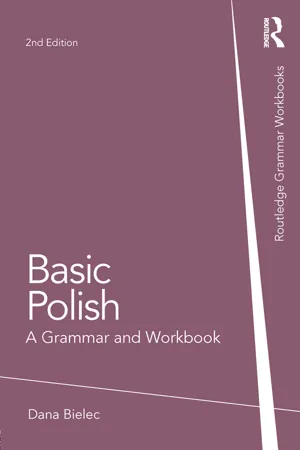
- 256 pages
- English
- ePUB (mobile friendly)
- Available on iOS & Android
About This Book
Basic Polish presents concise explanations of grammar with related exercises, to build confidence in using the modern language.
Assuming no previous knowledge of Polish, the book's step-by-step approach guarantees a thorough grounding in the basics of grammar. Each of the forty units introduces particular grammar points. Clear and concise explanations are supported by a wide range of examples and exercises to allow students to practise and consolidate their learning. Later units also reinforce material taught in earlier ones.
Key features include:
-
- clear, accessible format
- many useful language examples
- jargon-free explanations of grammar
- abundant exercises with a full answer key
- notes on the Polish alphabet, pronunciation and stress
- Polish-English vocabulary
- subject index.
This second edition has been revised to include updated examples and explanations. It also offers five new appendices containing a comprehensive summary of grammar functions, guidance on studying an inflected language, and helpful information on question words, the important verbs by? and mie? and perfective and imperfective verb aspects.
Written by an experienced language teacher and author, Basic Polish is the ideal introduction to the structures and expressions most widely used in spoken and written Polish. It is suitable for both independent use and classroom study.
Frequently asked questions
Information
Noun genders; adjective agreement; personal pronouns; być; address forms
| Mam syna. Syn jest chory. | I have a son. My son is ill. |
| Samochód jest drogi. | A/the/my etc. car is expensive. |
| Gdzie są dzieci? | Where are the/my etc. children? |
| Czy masz pieniądze? | Do you have the/some/any money? |
Nominative (subject) case of nouns
| We (nom.) are tired (nom.). | |
| but | I (nom.) am a good student (instr.). |
| Jack (nom.) has become a doctor (instr.). |
Masculine nouns in the nominative singular
Feminine nouns in the nominative singular
Table of contents
- Cover
- Half Title
- Title Page
- Copyright Page
- Table of Contents
- Introduction
- List of abbreviations
- Alphabet; pronunciation; stress
- 1 Noun genders; adjective agreement; personal pronouns; być; address forms
- 2 Nouns and adjectives in the plural
- 3 Plural of ‘men’ nouns and adjectives
- 4 Direct object (feminine and neuter)
- 5 Verbs with present tense -am, -a, -ają
- 6 Direct object of masculine nouns (accusative case)
- 7 Prepositions followed by accusative case
- 8 Direct object (singular) of masculine ‘alive’ nouns
- 9 Direct object (plural) of masculine ‘men’ nouns
- 10 Direct object pronouns; prepositional pronouns (accusative)
- 11 Possession (singular nouns)
- 12 Possession (plural nouns); whose
- 13 Genitive case of adjectives
- 14 Prepositions followed by genitive case
- 15 Verbs with genitive case object; prepositional pronouns (genitive)
- 16 Verbs with present tense -em, -e, -eją/-edzą
- 17 Cardinal numbers 1 to 4
- 18 Numbers 5 to 20; indefinite numbers; quantities
- 19 Ordinal numbers 1 to 20; name; age
- 20 Questions
- Verbs ending in -ować, -iwać, -awać, -ywać; verb aspects
- Negation; simple conjunctions; there is/are; something
- 23 Indirect object (singular); verbs with present tense -ę, -y, -ą
- 24 Indirect object (plural); dative case prepositions
- 25 More verbs with present tense -ę, -y, -ą
- 26 Dative case of pronouns
- 27 Pronoun się; verbs with present tense -ię/-ę, -i, -ią/-ą
- 28 Instrumental case (nouns, adjectives)
- 29 Other uses of instrumental case
- 30 Prepositions followed by instrumental case
- 31 Verbs with two imperfective forms
- 32 Locative case (nouns, prepositions)
- 33 Locative case (adjectives, pronouns)
- 34 This, that, such, what like, which
- 35 My, your, etc., own
- 36 Each, every, all
- 37 Clock time
- 38 Być (past, future); days
- 39 Months; seasons; time expressions
- 40 Dual-case prepositions
- Appendix 1: How grammar works
- Appendix 2: Studying an inflected language
- Appendix 3: Question words
- Appendix 4: Verbs być and mieć – all tenses
- Appendix 5: Perfective and imperfective verb aspects
- Key to exercises
- Polish–English vocabulary
- Index